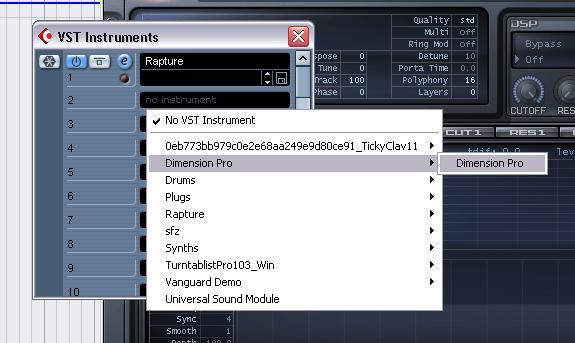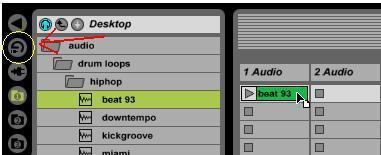Using Cakewalk Instruments in OS X Hosts
Last updated on 3/31/2016Note: This tip is also available for download as a .pdf
Introduction
This guide is broken into multiple sections and provides information on using Cakewalk Instruments within various hosts and sequencers on OS X. Whilst this guide cannot provide complete setup information for a specific host/sequencer; it can be used to ensure that your product is installed properly. For more detailed information on using software instruments within your host you will need to refer to its documentation. Documentation for Cakewalk Instruments is included on the installation disk and can be brought up from within the instruments interface by pressing F1 on your computer keyboard. This guide is split up into the following sections:
Inserting Cakewalk Instruments into compatible hosts/sequencers - This section provides basic setup information for a variety of hosts.
What to do if a plug-in is not appearing in an OS X host - Use this section if your instrument is not showing up as an available plug-in or instrument in an Apple OS X compatible host.
| Table of Contents - - | ||||
| Ableton Live | Inserting | Not Appearing | ||
| Apple Garage Band | Inserting | Not Appearing | ||
| Apple Logic | Inserting | Not Appearing | ||
| Digidesign ProTools | Inserting | Not Appearing | ||
| MOTU Digital Performer 4.6 + | Inserting | Not Appearing | ||
| Steinberg Cubase + Nuendo | Inserting | Not Appearing | ||
Ableton Live - - Inserting Into a Project
Create a new MIDI track from the Insert menu and then Click on the Devices view button.
From here you will be able to find your Cakewalk Instrument. Drag the instrument to the MIDI track. Ableton has also created a video tutorial on doing this that you can watch here.
Ableton Live - - Cakewalk Instrument is Not Appearing
If you can’t see your plug-in in Ableton Live you will need to force a rescan. Try the following:
- Click Preferences | File Folder
- Under the heading ‘Plug-in Sources’ make sure that you have ‘Use Audio Units’ turned on.
- Press the Rescan button.
If your plug-in is still not appearing you will need to try the following:
- Close Live
- Navigate to the following directory: Macintosh_HD/Users/YOURNAME/Library/Preferences/Ableton
- Locate and delete the file named ‘Preferences.cfg’
- Restart Live
Apple Garage Band - - Inserting Into a Project
Create a new track by clicking on the New Track button (the plus sign in the bottom left corner) and then click on the “Software Instruments Tab.”
All available instruments will be listed, select the Cakewalk Instrument you'd like to use and then click Create.

Apple Garage Band - - Cakewalk Instrument is Not Appearing
If you are unable to load your plug-in in Garage Band the most likely culprit is that you are using an outdated version of the plug-in. To resolve this try the following:
- Download and install the latest version of your Cakewalk Instrument from here
- Close Garage Band
- Navigate to the following directory: Macintosh_HD/Users/YOURNAME/Library/Caches
- Locate and trash the following file: ‘com.apple.audiounits.cache’
Apple Logic - - Inserting Into a Project
You can find the audio instruments in the Environment window. Make sure that the layers tab on the left is set to 'Audio'. Scroll about halfway to the right (at least in the default setup) and you'll get to a block of mixer strips that are named "AudioInst 1" etc.

Clicking on the topmost of the two I/O bars in an instrument strip gives you a popup where you can pick an instrument to insert.

Additionally, detailed information on using Cakewalk instruments in Multitimbral mode can be found here.
Apple Logic - - Cakewalk Instrument is Not Appearing
Occasionally, Logic users can run into problems when updating from an early Audio Unit to a more recent one or when installing an Audio Unit for the first time. If you encounter this, please do the following:
- Open Logic's AU manager; this can be found under the Logic Menu | Preferences | Start Logic AU Manager
- Check the box next to the plug-in you want to use. If the check box is unavailable or grayed out you may need to update to the latest version.
- Press the Rescan button to scan the plug-in. If the plug-in still fails validation do the following:
- Make sure you have the installed the latest version of your Cakewalk instrument from here.
- Ensure that the plug-in is installed in the following location: Macintosh_HD/Library/Audio/Plug-Ins/Components
- If it is not, you will need to reinstall the plug-in. If it is restart your computer, and rescan the plug-in using Logic’s AU Manager.
Digidesign ProTools - - Inserting Into a Project
Click Track | New Track. Select “Stereo” and then “Instrument Track”. This type of track streams the instrument’s audio playback and contains the MIDI that’s fed to the synth. Add your Cakewalk Instrument in the track’s insert. DigiDesign has a usefule video on using instrument tracks that can be found here.
Digidesign ProTools - - Cakewalk Instrument is Not Appearing
- First you will want to check the following directory to see if the instrument was installed: Macintosh_HD/Library/Application Support/Digidesign/Plug-Ins
- If you do not see your plug-in in the folder you will need to reinstall it and verify its installation path. The RTAS component must be installed in this directory.
- If you do see your plug instrument in the folder, then it is likely you are not using the latest version. Pro Tools only supports the RTAS plug-in format. Some of our instruments require a free update to support this format. Check our support site to ensure you have the latest version.
- Once you have updated to the correct version, re-opening Pro Tools will rescan your plug-ins folder.
MOTU Digital Performer 4.6 + - - Inserting Into a Project
You can create a DP instrument track by going to Project | Add Track | Instrument Track and selecting your Cakewalk Instrument from the sub-menu. Select the synth you would like to use and a new track is created, with that synth in the uppermost insert slot.
In order to hear sound from your synth you will need to select an audio output for it. Until an output is selected you will be unable to see the synth or instrument’s interface.
Additionally, you will need to insert a midi track into your project and set its output to your synth/instrument to hear sound.
MOTU Digital Performer 4.6 + - - Cakewalk Instrument is Not Appearing
Digital Performer scans all of the installed plug-ins on your system when you launch the application. Your Cakewalk Instrument will be available by clicking Project | Add Track | Instrument. If you do not see your instrument in this list you will need to do the following:
- Ensure you are using the latest version of the instrument. You can get the latest updates and patches from out support site.
- Close Digital Performer and navigate to the following directory: Macintosh_HD/users/YOURNAME/Library/Preferences/Digital Performer
- Delete the file ‘Audio Unit Info Cache’
- Open Digital Performer; your Cakewalk Instrument should now be available.
Steinberg Cubase + Nuendo - - Inserting Into a Project
First, click Devices | VST Instruments. Left-click on the next available fields that says “no instrument” and select the synth you would like to use from the list.

Now create a new MIDI Track by going to Project | Add Track | MIDI. Using the "Inspector", set the new MIDI Track’s output to your instrument.
Steinberg Cubase + Nuendo - - Cakewalk Instrument is Not Appearing
- Open the Devices Menu.
- Click on "Plug-in Information"
- Click on the “VST Plug-ins” tab
- Click the ‘Add …’ button to add a new scan folder
- Add the directory you installed your Cakewalk Instrument into
- Your instrument should now be available.



